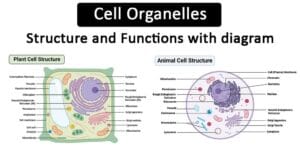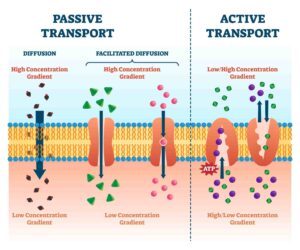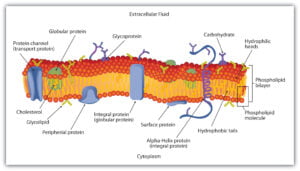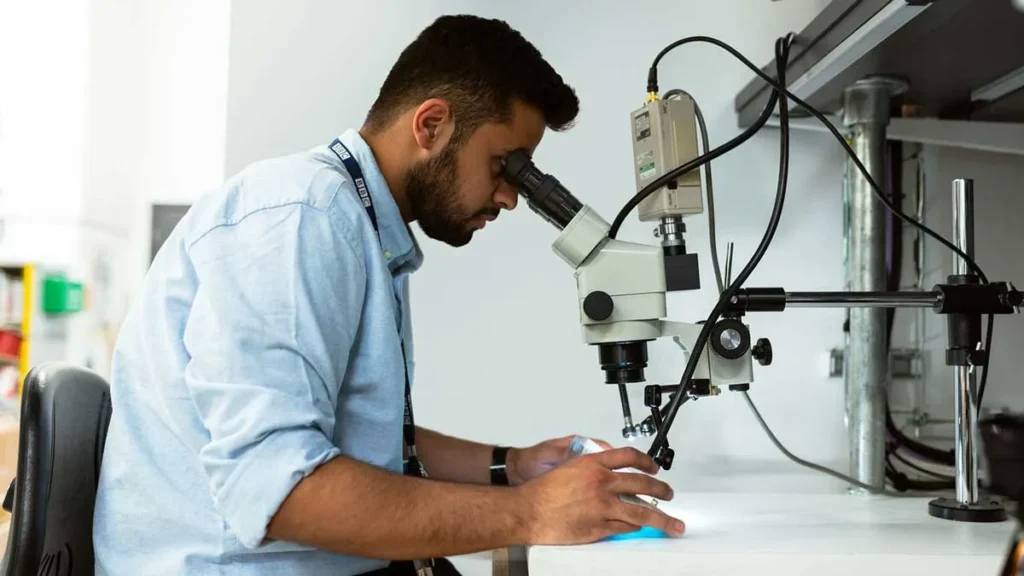Introduction – Passive Transport
Passive transport is a fundamental process in cell biology that allows substances to move across cell membranes without the direct input of cellular energy. The cell membrane, or plasma membrane, plays a crucial role in maintaining the integrity of the cell and controlling the passage of various molecules. Passive transport is driven by the inherent kinetic energy of particles and relies on the principles of diffusion and osmosis.
Key Points about Passive Transport:
- Selective Permeability: The cell membrane is selectively permeable, meaning it allows certain substances to pass through while restricting the movement of others. This selectivity is essential for maintaining the internal environment of the cell.
- Concentration Gradient: Passive transport relies on the concentration gradient of substances. Molecules move from areas of higher concentration to areas of lower concentration. This movement occurs until equilibrium is reached, and there is an equal distribution of the substance on both sides of the membrane.
- No Energy Expenditure: Unlike active transport, which requires energy (usually ATP) to move molecules against their concentration gradient, passive transport does not involve energy expenditure by the cell.
- Types of Passive Transport:
- Simple Diffusion: Small, non-polar molecules move directly through the lipid bilayer.
- Facilitated Diffusion: Larger or polar molecules use transport proteins for facilitated movement.
- Osmosis: The movement of water across a membrane from an area of lower solute concentration to an area of higher solute concentration.
- Functions: Passive transport serves essential functions in cells, including nutrient uptake, waste removal, gas exchange, and maintaining cell shape. It ensures that cells receive the necessary substances for their survival and eliminate waste products.
- Dynamic Equilibrium: As substances move passively across the membrane, they reach a state of dynamic equilibrium where the net movement continues, but there is no further accumulation on one side.
Understanding passive transport is crucial for comprehending the basic physiological processes occurring in cells. It is a dynamic and essential mechanism that contributes to the overall homeostasis and functionality of living cells.
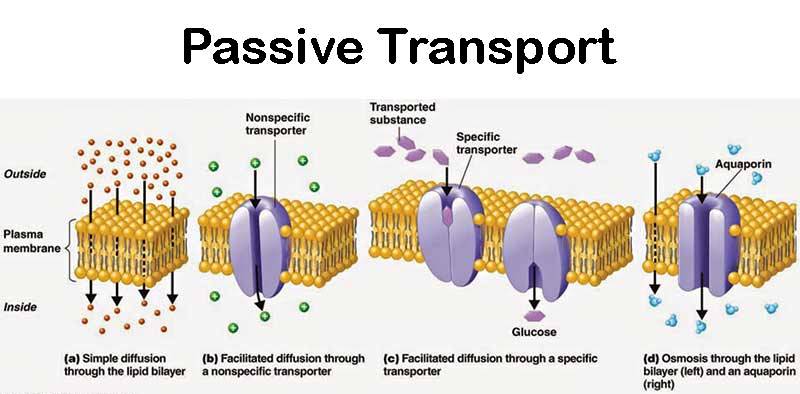
Features of Passive Transport:
- No Energy Input: Passive transport does not require energy input from the cell. It relies on the inherent kinetic energy of particles, and substances move along their concentration gradient spontaneously.
- Concentration Gradient: Movement in passive transport occurs along a concentration gradient, moving from areas of higher concentration to areas of lower concentration. This is a natural process driven by the tendency of the system to increase entropy.
- Entropy-Driven: Unlike active transport, which actively expends energy to move substances against their concentration gradient, passive transport is driven by the system’s tendency to increase entropy and achieve equilibrium.
- Rate Depends on Permeability: The rate of passive transport is influenced by the permeability of the cell membrane. Permeability is determined by the organization and characteristics of membrane lipids and proteins. A more permeable membrane allows for faster passive transport.
- Mechanisms: Passive transport can occur through simple diffusion, where small, non-polar molecules move directly through the lipid bilayer. It can also occur through pores or channels in the plasma membrane, facilitating the movement of specific substances.
- Materials of Small Molecular Weight: Passive transport is suitable for moving materials of small molecular weight. This includes gases, small polar molecules, and lipid-soluble substances.
- Independent of Membrane Proteins: While facilitated diffusion, a form of passive transport, involves membrane proteins, passive transport, in general, does not depend on energy-consuming processes or the involvement of membrane proteins. Simple diffusion, for instance, occurs directly through the lipid bilayer.
- Independent of Catabolism: Passive transport is independent of the catabolism (breakdown) of biological molecules for energy. It relies on the natural movement of substances based on concentration differences.
Types of Passive Transport
The four main kinds of passive transport are simple diffusion, facilitated diffusion, filtration, and/or osmosis.
Simple Diffusion:
Definition: Simple diffusion is a passive process where a single substance moves from an area of higher concentration to an area of lower concentration until equilibrium is reached. This movement occurs without the expenditure of energy.
Key Points:
- Passive Process: Diffusion is a passive transport mechanism, meaning it doesn’t require the input of energy from the cell. It is driven by the inherent kinetic energy of molecules.
- Concentration Gradient: Substances move down their concentration gradient, from regions of higher concentration to regions of lower concentration. This process continues until an equilibrium is achieved.
- Occurrence within the Cell: In cells, materials move within the cytosol by simple diffusion. This is an essential process for the distribution of ions and small molecules.
- Across Plasma Membrane: Simple diffusion also plays a role in substances moving through the plasma membrane. Small, non-polar molecules can move directly through the lipid bilayer.
- No Energy Expenditure: Unlike active transport, simple diffusion does not expend energy. Instead, it relies on the inherent potential energy created by concentration differences.
- Factors Affecting Rate:
- Concentration Gradient: The greater the difference in concentration, the faster the diffusion. As equilibrium is approached, the rate of diffusion slows.
- Mass of Molecules: More massive molecules diffuse more slowly because of increased difficulty in moving through the substance.
- Temperature: Higher temperatures increase molecular movement, accelerating the rate of diffusion.
- Solvent Density: Increased solvent density can decrease the rate of diffusion. Higher density makes it more challenging for molecules to move through the medium.
Understanding these factors helps explain the dynamics of simple diffusion. It is a fundamental process that contributes to the movement and distribution of substances within cells and across cell membranes, maintaining essential cellular functions.
Facilitated Diffusion:
Definition: Facilitated diffusion, also known as facilitated transport, is a passive process where substances move across the plasma membrane with the aid of transmembrane proteins. This movement occurs down a concentration gradient, from an area of higher concentration to an area of lower concentration, and it does not require cellular energy.
Key Points:
- Assisted Transport: Facilitated diffusion involves the assistance of transmembrane proteins to transport substances across the membrane. This mechanism helps the movement of substances that wouldn’t easily diffuse across the membrane.
- Concentration Gradient: Similar to simple diffusion, facilitated diffusion occurs down a concentration gradient. The substances move from regions of higher concentration to regions of lower concentration.
- Role of Transmembrane Proteins: Transmembrane proteins play a crucial role in facilitating the movement of substances. They act as receptors, initially binding with the material on the exterior surface of the membrane.
- Attachment to Receptors: The material to be transported attaches to protein or glycoprotein receptors on the cell’s membrane surface. This initial attachment allows the cell to selectively remove needed materials from the extracellular fluid.
- Integral Proteins: Specific integral proteins facilitate the passage of substances through the membrane. These proteins can form channels or pores, providing a pathway for certain substances to move through the membrane.
- Transport Proteins: The integral proteins involved in facilitated transport are collectively termed transport proteins. They function as either channels, allowing specific ions or molecules to move through, or carriers, facilitating the transport of substances across the membrane.
Facilitated diffusion is essential for the transport of polar or large substances that cannot easily traverse the lipid bilayer of the membrane. This process ensures the selective movement of necessary materials into and out of the cell, contributing to cellular homeostasis and proper functioning.
Filtration:
Definition: Filtration is a passive transport process involving the movement of water and solute molecules across a cell membrane. This movement is driven by hydrostatic pressure generated by the cardiovascular system. Filtration occurs selectively based on the size of membrane pores, allowing only substances of a certain size to pass through.
Key Points:
- Hydrostatic Pressure: Filtration relies on hydrostatic pressure, which is the force exerted by fluids like blood within the cardiovascular system. This pressure pushes water and solute molecules through the membrane.
- Membrane Pores: The size of membrane pores determines what substances can pass through. In certain structures like the Bowman’s capsule in the kidneys, the pores are very small, allowing only smaller solutes, such as albumins (the smallest proteins), to be filtered.
- Selective Permeability: Filtration is a selective process based on the permeability of the membrane. The size and characteristics of the pores determine which substances are allowed to pass from one side of the membrane to the other.
- Examples in the Body: Filtration is prominently observed in physiological processes. For instance, the Bowman’s capsule in the kidneys filters small solutes and water from the blood into the renal tubules. In the liver, cells have larger membrane pores, allowing various solutes to pass through for metabolic processes.
Filtration is essential for maintaining proper fluid balance and eliminating waste products in the body. It plays a crucial role in processes like kidney function, where selective filtration ensures that essential substances are retained while waste products are excreted. The size-based selectivity of filtration contributes to the overall functionality of different organs and tissues in the body.
Osmosis:
Definition: Osmosis is a passive transport process involving the diffusion of water through a semipermeable membrane, driven by the concentration gradient of water across the membrane. It is a special case of diffusion where only water molecules move through the membrane, and the membrane restricts the diffusion of solutes in the water.
Key Points:
- Semipermeable Membrane: Osmosis occurs through a semipermeable membrane, which allows the passage of water but limits the diffusion of solutes. The membrane selectively permits the movement of water molecules based on their concentration gradient.
- Concentration Gradient: Water, like other substances, moves from an area of higher concentration to an area of lower concentration. Osmosis continues until the concentration gradient of water reaches equilibrium, and it is a constant process in living systems.
- Types of Osmotic Solutions:
- Isotonic Solution: The extracellular solute concentration is balanced with the concentration inside the cell. In an isotonic solution, water molecules move between the solutions, but the rates are the same from both directions, resulting in balanced water movement.
- Hypotonic Solution: The solute concentration outside the cell is lower than inside. Water moves into the cell, down its concentration gradient, potentially causing the cell to swell.
- Hypertonic Solution: The solute concentration is higher than inside the cell. Water moves out of the cell, leading to cell shrinkage.
- Balanced Water Movement: In an isotonic solution, the rates of water movement into and out of the cell are equal, maintaining a balanced state. Hypotonic and hypertonic solutions, on the other hand, result in uneven water movement, impacting cell volume.
Osmosis plays a vital role in maintaining water balance within cells and organisms. The selective permeability of membranes and the movement of water based on concentration gradients contribute to cellular homeostasis and various physiological processes. Understanding osmotic solutions is crucial for comprehending the effects of different environmental conditions on cells and their structures.
Channels and Carrier Proteins for Passive Transport (Facilitated Transport Protein):
Introduction: In facilitated diffusion, a form of passive transport, molecules move across the plasma membrane with the assistance of membrane proteins. Channels and carrier proteins are two types of transmembrane proteins that facilitate the movement of molecules across the hydrophobic core of the membrane.
Channels:
- Definition: Channel proteins span the membrane, creating hydrophilic tunnels that allow specific molecules to pass through via diffusion.
- Selectivity: Channels are highly selective, accepting only one type of molecule or a few closely related molecules for transport.
- Hydrophobic Core Bypass: These proteins enable polar and charged compounds to avoid the hydrophobic core of the plasma membrane, which would otherwise impede or block their entry.
- Open and Gated Channels: Some channels are open all the time, while others are “gated,” meaning they can open or close in response to specific signals, such as electrical signals or the binding of a molecule.
- Example – Aquaporins: Aquaporins are channel proteins that facilitate the rapid movement of water across the membrane. They are essential in plant cells, red blood cells, and specific kidney regions, minimizing water loss in urine.
Carrier Proteins:
- Definition: Carrier proteins are another class of transmembrane proteins involved in facilitated transport. They can change their shape to transport a target molecule from one side of the membrane to the other.
- Selective Nature: Carrier proteins, like channels, exhibit selectivity, typically for one or a few specific substances.
- Shape Change: Carrier proteins change their shape in response to the binding of their target molecule. This shape change facilitates the movement of the molecule across the membrane.
- Facilitated Diffusion: Carrier proteins involved in facilitated diffusion provide hydrophilic molecules with a pathway to move down an existing concentration gradient without requiring energy input. They differ from active transport proteins, which actively pump substances against their concentration gradient.
Significance:
- Channels and carrier proteins are crucial for allowing specific molecules, especially polar or charged ones, to traverse the membrane, which they couldn’t do efficiently through the hydrophobic core.
- These proteins contribute to maintaining cellular homeostasis by regulating the passage of essential molecules across the membrane.
- The selectivity of channels and carriers ensures precision in the transport of specific substances, preventing unwanted or uncontrolled entry or exit.
Understanding the roles of channels and carrier proteins in facilitated diffusion provides insights into the mechanisms that cells employ to control the movement of molecules across membranes.
Significance of Passive Transport:
Essential for Cellular Life:
- Membrane transport, particularly passive transport, is fundamental for cellular life. It allows the exchange of essential molecules, supporting cellular functions and maintaining homeostasis.
Blood-Brain Barrier:
- Passive diffusion is crucial at the blood-brain barrier, where specific molecules, like sodium thiopental, can diffuse across the membrane. This mechanism regulates the entry of substances into the brain, ensuring a controlled environment for neural function.
Placental Exchange:
- Passive diffusion plays a vital role across the placenta, facilitating the exchange of solute particles between the mother and the fetus. This ensures the transfer of necessary nutrients and substances for fetal development.
Digestion and Nutrient Transport:
- Passive transport mechanisms, such as diffusion and osmosis, are involved in the movement of small molecular weight materials during digestion. Nutrients like amino acids and glucose move down concentration gradients from the intestine to the blood.
Waste Product Removal:
- Waste products generated in cells, such as carbon dioxide and urea, are transported by diffusion from body cells into the bloodstream. This process ensures the removal of metabolic waste from cellular environments.
Respiratory Gas Exchange:
- Passive transport is critical for the exchange of respiratory gases. Oxygen moves from areas of high concentration (air sacs) to lower concentration (blood), while carbon dioxide moves from high concentration (blood) to lower concentration (air sacs) during breathing.
Osmosis and Cellular Nutrient Distribution:
- Osmosis, a form of passive transport, facilitates the distribution of essential nutrients in the body. Cells have semipermeable membranes, and osmosis enables the passage of liquid solvents through these membranes.
Renal Filtration in Animals:
- In animals, including humans, renal filtration relies on passive transport to remove waste from the blood. This process is vital for maintaining proper fluid and electrolyte balance in the body.
Maintenance of Homeostasis:
- Passive transport contributes to the maintenance of homeostasis by regulating the movement of ions, nutrients, and waste products across cellular and organ membranes.
Understanding the significance of passive transport underscores its role in various physiological processes, ensuring the proper functioning and survival of cells and organisms.

